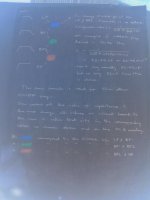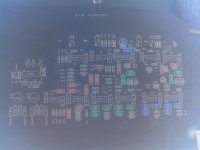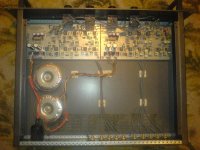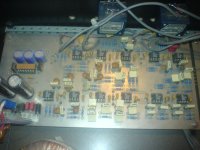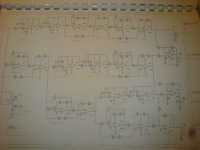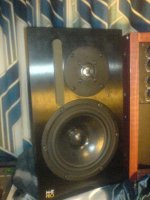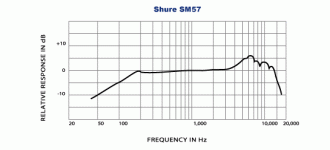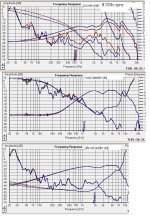hello!
first post here, a top forum for much needed info.. cheers😀
so I have been collecting these components over the years:
Quad 405 amp (upgraded),
cheap prebuilt passive (2300hz) crossover,
music labs active 4 way linear phase crossover (audio labs of melbourne)
seas 25 TAF/DWTV 6ohm tweeters http://www.seas.no/images/stories/vintage/pdfdataheet/h0569_25tafdtv.pdf
vifa 6.5" treated paper 10 ohm midwoofers N-DRV-3-8-1
speakers are NHTpro A-20 (minus the original amp and crossovers which were 2100hz)
and it sounds good with fast punchy bass, but around the cross over frequency theres a 2+db spike and the treble is generally a bit harsh.
i'm trying to get this system to sound decent in a small recording room on a budget and i was hoping for some advice about wether to just upgrade the passive crossover to a high quality one.. is that likely to drastically improve sound quality?
or try and use the music labs active crossover and keep the quad 405 for vifa bass drivers only and get dedicated amps for the tweeters and adding a powered sub.
this would involve changing cap values in the active crossover which is painful! but it might be worth the trouble.
also, at the moment it's 3.75 ohm total for the speakers without including the crossover and assuming the crossover is 4 or 8 ohm that could be 1.9 ohm - 2.5 ohm load on the quad 405. is this ok?
any ideas appreciated
regards, gabby
first post here, a top forum for much needed info.. cheers😀
so I have been collecting these components over the years:
Quad 405 amp (upgraded),
cheap prebuilt passive (2300hz) crossover,
music labs active 4 way linear phase crossover (audio labs of melbourne)
seas 25 TAF/DWTV 6ohm tweeters http://www.seas.no/images/stories/vintage/pdfdataheet/h0569_25tafdtv.pdf
vifa 6.5" treated paper 10 ohm midwoofers N-DRV-3-8-1
speakers are NHTpro A-20 (minus the original amp and crossovers which were 2100hz)
and it sounds good with fast punchy bass, but around the cross over frequency theres a 2+db spike and the treble is generally a bit harsh.
i'm trying to get this system to sound decent in a small recording room on a budget and i was hoping for some advice about wether to just upgrade the passive crossover to a high quality one.. is that likely to drastically improve sound quality?
or try and use the music labs active crossover and keep the quad 405 for vifa bass drivers only and get dedicated amps for the tweeters and adding a powered sub.
this would involve changing cap values in the active crossover which is painful! but it might be worth the trouble.
also, at the moment it's 3.75 ohm total for the speakers without including the crossover and assuming the crossover is 4 or 8 ohm that could be 1.9 ohm - 2.5 ohm load on the quad 405. is this ok?
any ideas appreciated
regards, gabby
read Linkwitz site.
thanks for the tip AndrewT, that is a very nice link & on the whole easy to understand. genius.
great! so that clarifies the situation for me, i will add this driver
https://www.madisound.com/store/product_info.php?products_id=1088
and a pair of diy powered subs, in order to make use of this really nice active 4 way cross over.
the only thing to decide now is what type of amplification to use as i will now need 2 stereo or 4 individual amps to drive the tweeters and dome midranges..
there are some quad 405 diy kits on ebay which could work and keep roughly the same power output to eac h driver. otherwise something like the F5 may be ok though it maybe a little under powered. (tweeters are 100w rms @ 6ohm, dome mids 80w rms @ 8 ohm)
does anyone have any suggestions for diy amp kits that can output 80-100w per channel and particularly suit mid to high freq's?
thanks again
does anyone have any suggestions for diy amp kits that can output 80-100w per channel and particularly suit mid to high freq's?
thanks again
Try here:
::: Aspen Amplifiers :::
Hugh has:
* 100w (into 8 ohms - 200w into 4 ohms) LifeForce 100 modules
* his new NAKSA 70 (70w into 8 ohms) and an upcoming NAKSA 100 (120w?)
* and possibly some of his earlier AKSA 100s (100w into 8 ohms)
for sale.
I use LF100s on my bass panels and LF55s on my mid panels & ribbons (active Maggies).
Regards,
Andy
They look really nice, especially the naksa 70 thanks for pointing this out andyr.. its good to hear there are some very talented local amp builders that dont JUST focus on the high price boutique amp market.
well over the last week i came back to earth and realised that with my current configuration its impractical to go active now with this 4 way crossover - its looking too expensive to implement and not ideal for studio monitoring. the expense being 3 matching stereo amps and extra drivers of course.
so back to plan A, quality passive crossover for these two way speakers..
so the question i have now is, these 61/2" and 1" speakers are stamped 10ohm and 6 ohm respectively, and when i used an online calculator
Series Parallel Speaker Impedance
for impedance in a parallel configuration i got 3.75ohms which is borderline i would imagine for the quad 405?
but, i disconnected the wires from the amp and measured across the wires of the (crappy) crossover and speaker circuit and it measures 8.6ohm
what i'm really trying to figure out is if i get a crossover like this
Dynaudio - Authentic Fidelity
or this
(2) Xtant/Morel 2-Way Adjustable Crossovers Macrom NEW - eBay Crossovers Only, Signal Processors, Car Electronics, Electronics. (end time 09-Oct-10 03:37:35 AEDST)
which are both 4 ohm, is it likely to be ok for the Quad 405 to handle?
i dont mean to appear totally confused here, but its obvious i am
cheers!
well over the last week i came back to earth and realised that with my current configuration its impractical to go active now with this 4 way crossover - its looking too expensive to implement and not ideal for studio monitoring. the expense being 3 matching stereo amps and extra drivers of course.
so back to plan A, quality passive crossover for these two way speakers..
so the question i have now is, these 61/2" and 1" speakers are stamped 10ohm and 6 ohm respectively, and when i used an online calculator
Series Parallel Speaker Impedance
for impedance in a parallel configuration i got 3.75ohms which is borderline i would imagine for the quad 405?
but, i disconnected the wires from the amp and measured across the wires of the (crappy) crossover and speaker circuit and it measures 8.6ohm
what i'm really trying to figure out is if i get a crossover like this
Dynaudio - Authentic Fidelity
or this
(2) Xtant/Morel 2-Way Adjustable Crossovers Macrom NEW - eBay Crossovers Only, Signal Processors, Car Electronics, Electronics. (end time 09-Oct-10 03:37:35 AEDST)
which are both 4 ohm, is it likely to be ok for the Quad 405 to handle?
i dont mean to appear totally confused here, but its obvious i am

cheers!
a passive crossover sends part of the signal to one driver in preference to allowing it to pass to another driver.
What this comes down to, for a 2way, is a high pass filter added to the input of the treble driver and a low pass filter added to the input of the bass/mid driver.
The amplifier does not see these two loads in parallel.
At different frequencies the amplifier sees these as alternative paths for the output current.
Well in truth the amplifier does see these loads in parallel, but when the filter is presented with a frequency outside it's passband it shows as a very high impedance. That high impedance in parallel with the in passband filter is roughly equivalent to the in passband filter alone.
The passive filters MUST be DESIGNED to match the impedance of the driver they are feeding.
That means the low pass filter must be designed to match up with the 10ohm bass/mid driver and the high pass filter must be designed to match up to the 6ohm treble driver.
The Quad 405 will see the crossover + drivers as an average load of ~ 9ohms.
What this comes down to, for a 2way, is a high pass filter added to the input of the treble driver and a low pass filter added to the input of the bass/mid driver.
The amplifier does not see these two loads in parallel.
At different frequencies the amplifier sees these as alternative paths for the output current.
Well in truth the amplifier does see these loads in parallel, but when the filter is presented with a frequency outside it's passband it shows as a very high impedance. That high impedance in parallel with the in passband filter is roughly equivalent to the in passband filter alone.
The passive filters MUST be DESIGNED to match the impedance of the driver they are feeding.
That means the low pass filter must be designed to match up with the 10ohm bass/mid driver and the high pass filter must be designed to match up to the 6ohm treble driver.
The Quad 405 will see the crossover + drivers as an average load of ~ 9ohms.
Last edited:
ahh that clears things up, thanks andrewT.
seems unlikely to find any off the shelf crossover for this system then.. and if those dynaudio crossovers won't do, would it difficult to design a quality custom crossover for these speakers?
or do you know of a thread here or even a simple program to generate a crossover circuit?
i can't imagine its overly complicated but i don't really know. if its not too difficult to make im up for it, as i have some proto boards and lots of components.
[edit] i just found this calculator thing and got this result:
1st Order Butterworth
2100 Hertz
6 Ohm Tweeter / 10 Ohm Woofer
Capacitors
C1 = 12.62 uF
Inductors
L1 = 0.76 mHis it really that simple?
thanks again for the advice!
gabby
seems unlikely to find any off the shelf crossover for this system then.. and if those dynaudio crossovers won't do, would it difficult to design a quality custom crossover for these speakers?
or do you know of a thread here or even a simple program to generate a crossover circuit?
i can't imagine its overly complicated but i don't really know. if its not too difficult to make im up for it, as i have some proto boards and lots of components.
[edit] i just found this calculator thing and got this result:
1st Order Butterworth
2100 Hertz
6 Ohm Tweeter / 10 Ohm Woofer
An externally hosted image should be here but it was not working when we last tested it.
Parts ListCapacitors
C1 = 12.62 uF
Inductors
L1 = 0.76 mHis it really that simple?
thanks again for the advice!
gabby
Last edited:
should i be looking at another type of crossover - 2nd or fourth order Linkwitz-Riley perhaps?
should the caps be high voltage rated?
best brand/type of caps for the job?
i would really like to get the best results from recordings with these speakers and happy to get top shelf components for the crossover but i'm just not sure where to go from here.. looks like its back to the linkwitzlab!
cheers
should the caps be high voltage rated?
best brand/type of caps for the job?
i would really like to get the best results from recordings with these speakers and happy to get top shelf components for the crossover but i'm just not sure where to go from here.. looks like its back to the linkwitzlab!
cheers
No, it's not really that simple unless your drivers are well behaved and flat well out of their pass bands - meaning that their impedance is flat along with frequency response.
Notice that your tweeter rolls off 2 Khz, so a first order electrical filter at 2Khz will get you a second order acoustic response (what we really care about). If the woofer doesn't have a similar roll off above 2 Khz, you'll probably need other than a first order filter to get a clean crossover.
One of the beauties of active crossovers is that they don't interact with the driver's impedance, so you don't need a network to compensate for the changes with frequency, making it a little easier to calculate filter values.
Do you have measurement capability? "A 2 dB spike" implies that you do. To get the best results, you'll need to measure the response and design the network, active or passive, accordingly.
If messing about with your active crossover, changing resistors usually gives you more options than changing capacitors if you are not changing the frequency by an order of magnitude or more. Resistors are available in far more values and tighter tolerances.
Notice that your tweeter rolls off 2 Khz, so a first order electrical filter at 2Khz will get you a second order acoustic response (what we really care about). If the woofer doesn't have a similar roll off above 2 Khz, you'll probably need other than a first order filter to get a clean crossover.
One of the beauties of active crossovers is that they don't interact with the driver's impedance, so you don't need a network to compensate for the changes with frequency, making it a little easier to calculate filter values.
Do you have measurement capability? "A 2 dB spike" implies that you do. To get the best results, you'll need to measure the response and design the network, active or passive, accordingly.
If messing about with your active crossover, changing resistors usually gives you more options than changing capacitors if you are not changing the frequency by an order of magnitude or more. Resistors are available in far more values and tighter tolerances.
hi Bob, i appreciate your input 🙂
i am in a pickle with these speakers as its a little difficult to be 100% certain of their specs. i have contacted NHT but received no reply but i've gathered info from various net sources , custom VIFA mid/bass and custom SEAS tweeter which is very much like the one i posted a link of. according to NHT Crossover is set at 2.1kHz, and both filters have 12dB/octave slopes. the codes are not on the web but brand and impedance are printed on the magnets.
these originally come from a monitoring system that has a dedicated 200w rackmount amp which also houses the crossovers from there it used special leads to the cabinets.. interestingly, i obtained them directly from DEQX as they were used in the development of the new (at the time) NHT nearfield monitoring system which incorporated DEQX technology.
so, in short i cant be sure of the specs which leads me to think that i should use the NHT stated crossover freq of 2100hz but the SEAS tweeter is recommended to use 3000hz on the datasheet.
"Do you have measurement capability? "A 2 dB spike" implies that you do. To get the best results, you'll need to measure the response and design the network, active or passive, accordingly. "
well no, i used a sweeping sine generator and decibel meter at 1 metre to narrow down the problem area and it was actually more than 2db on the meter but to my ears around 2db.
the crossover i'm using is really cheap, $10 so i would expect it to be bad. i have not tried to analyse the individual drivers yet, for lack of a reliable method. i do have mics and a pc setup which may be of help but im not sure if there are any reliable free software available?
. "If messing about with your active crossover, changing resistors usually gives you more options than changing capacitors if you are not changing the frequency by an order of magnitude or more. Resistors are available in far more values and tighter tolerances."
i see, yes i am having trouble finding the required caps to alter freqs. though in the supplied manual with the active crossover it details how to change the freqs, there is no mention of resistors so i would not know where to start there!
i really would love to use this crossover as i believe it is hand made by a great local audio engineer Jon De Sensi. it should be used but i would need to find suitable amps and a extra mid ranges and subs for a reasonable cost! maybe its better to buy (or build) an active two way crossover if reliably designing a passive one is too complicated?
cheers, gabby
i am in a pickle with these speakers as its a little difficult to be 100% certain of their specs. i have contacted NHT but received no reply but i've gathered info from various net sources , custom VIFA mid/bass and custom SEAS tweeter which is very much like the one i posted a link of. according to NHT Crossover is set at 2.1kHz, and both filters have 12dB/octave slopes. the codes are not on the web but brand and impedance are printed on the magnets.
these originally come from a monitoring system that has a dedicated 200w rackmount amp which also houses the crossovers from there it used special leads to the cabinets.. interestingly, i obtained them directly from DEQX as they were used in the development of the new (at the time) NHT nearfield monitoring system which incorporated DEQX technology.
so, in short i cant be sure of the specs which leads me to think that i should use the NHT stated crossover freq of 2100hz but the SEAS tweeter is recommended to use 3000hz on the datasheet.
"Do you have measurement capability? "A 2 dB spike" implies that you do. To get the best results, you'll need to measure the response and design the network, active or passive, accordingly. "
well no, i used a sweeping sine generator and decibel meter at 1 metre to narrow down the problem area and it was actually more than 2db on the meter but to my ears around 2db.
the crossover i'm using is really cheap, $10 so i would expect it to be bad. i have not tried to analyse the individual drivers yet, for lack of a reliable method. i do have mics and a pc setup which may be of help but im not sure if there are any reliable free software available?
. "If messing about with your active crossover, changing resistors usually gives you more options than changing capacitors if you are not changing the frequency by an order of magnitude or more. Resistors are available in far more values and tighter tolerances."
i see, yes i am having trouble finding the required caps to alter freqs. though in the supplied manual with the active crossover it details how to change the freqs, there is no mention of resistors so i would not know where to start there!
i really would love to use this crossover as i believe it is hand made by a great local audio engineer Jon De Sensi. it should be used but i would need to find suitable amps and a extra mid ranges and subs for a reasonable cost! maybe its better to buy (or build) an active two way crossover if reliably designing a passive one is too complicated?
cheers, gabby
Attachments
Last edited:
Ideally your mike will be calibrated, but many are flat in the crossover region, which is most important. Download Holm Impulse and measure away.
Your active crossover looks like unity gain Sallen-Key topology on the low pass sections, set up for LR4 all around. (indicated by the double caps and resistors) Go to Elliott Sound Products - The Audio Pages (Main Index) and download Rod's LR component calculator. The high pass is multi feedback (MFB), for that go to Active Filter Design Application - FILTERPRO - TI Software Folder and use TI's filter pro program to calculate values.
There are a couple interesting things about your filter. It is a subtractive filter - the bandpass and high pass sections are fed an inverted signal of the band below them to generate their high pass function. Note that the high pass sections are bypassed with resistors and that each leg has all the crossover frequencies involved.
This isn't a topology that I have used, but it looks like you could substitute your desired crossover frequencies. I'm not quite sure what to do about turning it into a 2 way (with sub?) though. It probably involves pulling R25/R51 and R45 and using a 10K to connect those legs and bypassing some sections in the low pass (and BP1).
Another thing to consider is adding a phase correction circuit and baffle step correction - see Linkwitz. Since the slopes in your crossover are textbook, you'll need to adjust the drive phase. You may also want to add some eq to flatten response, either a notch/boost or shelving. Baffle step compensation is required unless your placement will be quite close to the rear wall.
Your active crossover looks like unity gain Sallen-Key topology on the low pass sections, set up for LR4 all around. (indicated by the double caps and resistors) Go to Elliott Sound Products - The Audio Pages (Main Index) and download Rod's LR component calculator. The high pass is multi feedback (MFB), for that go to Active Filter Design Application - FILTERPRO - TI Software Folder and use TI's filter pro program to calculate values.
There are a couple interesting things about your filter. It is a subtractive filter - the bandpass and high pass sections are fed an inverted signal of the band below them to generate their high pass function. Note that the high pass sections are bypassed with resistors and that each leg has all the crossover frequencies involved.
This isn't a topology that I have used, but it looks like you could substitute your desired crossover frequencies. I'm not quite sure what to do about turning it into a 2 way (with sub?) though. It probably involves pulling R25/R51 and R45 and using a 10K to connect those legs and bypassing some sections in the low pass (and BP1).
Another thing to consider is adding a phase correction circuit and baffle step correction - see Linkwitz. Since the slopes in your crossover are textbook, you'll need to adjust the drive phase. You may also want to add some eq to flatten response, either a notch/boost or shelving. Baffle step compensation is required unless your placement will be quite close to the rear wall.
Hi Bob,
great reply! I wasn't expecting such a comprehensive breakdown.. its really interesting though, plenty of reading to do. I'm just messing around with the Holm impulse at the moment. cheers 🙂
great reply! I wasn't expecting such a comprehensive breakdown.. its really interesting though, plenty of reading to do. I'm just messing around with the Holm impulse at the moment. cheers 🙂
Hi,
Oh no, looks like the incarnation of one of Stephen King´s books..."OP-amp cemetary" ;-) The only intersting thing I find about that filter is: How can anybody design such a *** thing?? I´m pretty sure that this will not only not work as intended but it surely will sound crappy with those myriads of OPs around.
Yes there are OPs in that schematic that subtract some signals of each other, but since no care is taken about the phase relationship of theses signals the sum of two subtracted channels wont be 1 again. This is not what a subtraction filter is meant to be. A subtraction filter only works well when the drivers are very well behaved and still well behaved at least one octave above or below the Xover-frequency. Typically this means additional equalizer circuitry. If one still wants a subtractive filter then search for Hawksford-Riley. Lowest parts count, matched and as such costier components are not needed and it offers highest symmetry of filter flanks and its truely subtractive. *lol*.
I would opt for a classical filter structure though where both channels are Xovered independantely. Since only a 2 way system is to be Xovered simple unity gain SallenKey structures are fine that can be implemented with simple discrete Buffer stages.
jauu
Calvin
Oh no, looks like the incarnation of one of Stephen King´s books..."OP-amp cemetary" ;-) The only intersting thing I find about that filter is: How can anybody design such a *** thing?? I´m pretty sure that this will not only not work as intended but it surely will sound crappy with those myriads of OPs around.
Yes there are OPs in that schematic that subtract some signals of each other, but since no care is taken about the phase relationship of theses signals the sum of two subtracted channels wont be 1 again. This is not what a subtraction filter is meant to be. A subtraction filter only works well when the drivers are very well behaved and still well behaved at least one octave above or below the Xover-frequency. Typically this means additional equalizer circuitry. If one still wants a subtractive filter then search for Hawksford-Riley. Lowest parts count, matched and as such costier components are not needed and it offers highest symmetry of filter flanks and its truely subtractive. *lol*.
I would opt for a classical filter structure though where both channels are Xovered independantely. Since only a 2 way system is to be Xovered simple unity gain SallenKey structures are fine that can be implemented with simple discrete Buffer stages.
jauu
Calvin
Last edited:
hi Calvin,
funny post! thanks for the input though, its really interesting to find out what this thing is or is not. as you can probably tell i'm trying to work out whether to use it or just get rid of it.
thanks for the input though, its really interesting to find out what this thing is or is not. as you can probably tell i'm trying to work out whether to use it or just get rid of it.
to be honest all this talk of myriads of OPs (opamps?) SallenKey structures and Hawksford-Riley stuff is interesting but i wont be designing my own active crossovers at this point, its above my skill level.
i can solder kits though! if you could recommend a kit or if anyone would care to design a simple crossover for me i would greatly appreciate that too.
but for now im back to the passive crossover plan probably the butterworth with high quality caps and coils. the sub idea is canned too.
i think i will use a higher crossover point than 2100hz to allow for the large frequency overlap. i think somewhere around 2800hz - 3000hz should be good. short of paying someone more than the speakers are worth to design it, its the best option i think.. ?
thanks everyone for the advice.
gabby
funny post!
 thanks for the input though, its really interesting to find out what this thing is or is not. as you can probably tell i'm trying to work out whether to use it or just get rid of it.
thanks for the input though, its really interesting to find out what this thing is or is not. as you can probably tell i'm trying to work out whether to use it or just get rid of it.to be honest all this talk of myriads of OPs (opamps?) SallenKey structures and Hawksford-Riley stuff is interesting but i wont be designing my own active crossovers at this point, its above my skill level.
i can solder kits though! if you could recommend a kit or if anyone would care to design a simple crossover for me i would greatly appreciate that too.
but for now im back to the passive crossover plan probably the butterworth with high quality caps and coils. the sub idea is canned too.
i think i will use a higher crossover point than 2100hz to allow for the large frequency overlap. i think somewhere around 2800hz - 3000hz should be good. short of paying someone more than the speakers are worth to design it, its the best option i think.. ?
thanks everyone for the advice.
gabby
after mucking around with HOLM software i made some measurements using a shure sm57 mic and found some interesting results..
i recorded the system response with the cheap passive crossover connected first and then the individual drivers.
from what i can gather, it looks like theres a huge bass hump below 80 hz that is a worry, also a dip between 600 hz and 1200 hz. theres a peak at the xover point 2300 hz ant the tweeter rolls off steadily after 10000 hz.
am i reading the graphs correctly?
could the amp or room placement be to blame for the massive bass lump?
i am now wondering if i should get a prebuilt active crossover like a rane 2 way rackunit, using a sub below 100hz. and keeping the crossover point around 2000-2100hz.
or just some kind of highpass filter (cap?) in the crossover what do you guys think?
cheers, gabby
i recorded the system response with the cheap passive crossover connected first and then the individual drivers.
from what i can gather, it looks like theres a huge bass hump below 80 hz that is a worry, also a dip between 600 hz and 1200 hz. theres a peak at the xover point 2300 hz ant the tweeter rolls off steadily after 10000 hz.
am i reading the graphs correctly?
could the amp or room placement be to blame for the massive bass lump?
i am now wondering if i should get a prebuilt active crossover like a rane 2 way rackunit, using a sub below 100hz. and keeping the crossover point around 2000-2100hz.
or just some kind of highpass filter (cap?) in the crossover what do you guys think?
cheers, gabby
Attachments
Last edited:
Notice the gating arrows on the bottom of your graphs? They are telling you that anything to the left of them is unreliable due to gating.
Look at your impulse measurements and set the gate to end just before the first reflection. The low end (below 3-400 Hz with that woofer) should be measured near field and spliced to the high end if you want to want a better representation of what's happening.
Try a log sine sweep or chirp instead of the MLS and see what a difference it makes.
I assume that's a generic curve for the SM57. You really should have a flatter mike, although Holm Impulse corrects for that, assuming you've entered it into the calibration file. Parts Express has their EMM-6 calibrated mike that is flatter over a broader range. There is some discussion whether the calibration file provided is for that particular mike, but it seems to have gotten better. You can get a calibrated mike from Cross·Spectrum Labs - Sound | Vibration | Engineering under $100. Herb calibrated my EMM-6, it was quite a bit different than the P-E supplied graph, but it was an early one.
Look at your impulse measurements and set the gate to end just before the first reflection. The low end (below 3-400 Hz with that woofer) should be measured near field and spliced to the high end if you want to want a better representation of what's happening.
Try a log sine sweep or chirp instead of the MLS and see what a difference it makes.
I assume that's a generic curve for the SM57. You really should have a flatter mike, although Holm Impulse corrects for that, assuming you've entered it into the calibration file. Parts Express has their EMM-6 calibrated mike that is flatter over a broader range. There is some discussion whether the calibration file provided is for that particular mike, but it seems to have gotten better. You can get a calibrated mike from Cross·Spectrum Labs - Sound | Vibration | Engineering under $100. Herb calibrated my EMM-6, it was quite a bit different than the P-E supplied graph, but it was an early one.
Engineering comments.
Dear neonleg and Calvin,
My first reaction looking at the active cross over schematic is its not what you want to use at this stage, though conceivably it could be adjusted to do the right thing.
I am of the opinion you need to do engineering with a series of prototypes one step at a time. The best solution will take a long time and a lot of effort, (more budget efficient is to buy some good active speakers on ebay I suspect) and with the repeated prototype approach you can stop when he budget runs out or benefits are so small your interest dies. (we don't all have Calvin's budget or persistence)
I would suggest that you start with a cross over that is adjustable. This will degrade sound quality and balance in the short term but give you a good idea about the correct cross over, It can be adjusted and measured easily with your system and allow you so see the effects of cross over frequency and tweeter / bass phase and gain. Some thing nasty like a CX3400 can easily be found on ebay cheap. In my opinion this made a better compromise than the Passive crossover found in my Linn Helix speakers, although the benefits and the disadvantages where close. On the pro side, Bass was improved almost without effort and with tuning (by ear using sweeps from computer) the speakers sounded better in the treble, but on the negatives it did require two amps and a lot of fiddling. Also on the negative side I could not help thinking the sound stage (not a Linn strong point in my opinion) was degraded further. I planned on building my own active cross over based on the cross over based on the experience of these drivers being driven actively.
Recently I moved to a Quad ESL 63 (Linns loose in sound quality so are returned to passive and now waiting for my ebay sales) and so that cross over could not do its job (designed for conventional cross over points) so I bought another adjustable semi pro active cross over, but for bass, and had similar feelings against it. I then built a Rod Eliot simple op amp cross over with a fixed frequency cross over, with cross over point selected on the basis of adjusting the adjustable bass cross over. I am almost happy with it, as the sound stage returned, but I still haven't finished the cross over to amp connection (do I go balanced? I think it might help on other issues more to do with power amps I have), and since I am almost as a perfectionist as Calvin after I have sorted out power management for the power amplifiers (I want auto power off before I go Class A for the electrostatics) I may revisit the cross over, and explore shunt feed back equalization, different cross over orders, and test Calvin's theories about op-amps being evil.
I personally think that your Quad 405 is the worst Quad amplifier I have ever owned but then unlike you I had speakers which where difficult to drive (quad ESL 57's). I never upgraded the capacitors, never replaced its input op-amp and sold it on rather quick with a blue rather than red LED which helped things sell in about 1994. Hopefully you have upgraded the 405 significantly so its better than my one.
Calvin has strong opinions on Opamps and is quiet a perfectionist, I have yet to do the required testing on the Opamps are evil direction, but at your budget and with a 405 amplifier I think that on this Opamp issue Clavin's suggestion is putting cart before the horses.
For a treble amplifier I would suggest you go with a cheap chip amplifier, as according to others in this site they are good, 10 Watts will be more power than you need for a actively crossed over treble amp, so you could reach Cavlin levels of perfectionism and go with a class A amplifier such as the JLH design, but I would start cheap as chips and continue down the active root.
Regards
Owen
Dear neonleg and Calvin,
My first reaction looking at the active cross over schematic is its not what you want to use at this stage, though conceivably it could be adjusted to do the right thing.
I am of the opinion you need to do engineering with a series of prototypes one step at a time. The best solution will take a long time and a lot of effort, (more budget efficient is to buy some good active speakers on ebay I suspect) and with the repeated prototype approach you can stop when he budget runs out or benefits are so small your interest dies. (we don't all have Calvin's budget or persistence)
I would suggest that you start with a cross over that is adjustable. This will degrade sound quality and balance in the short term but give you a good idea about the correct cross over, It can be adjusted and measured easily with your system and allow you so see the effects of cross over frequency and tweeter / bass phase and gain. Some thing nasty like a CX3400 can easily be found on ebay cheap. In my opinion this made a better compromise than the Passive crossover found in my Linn Helix speakers, although the benefits and the disadvantages where close. On the pro side, Bass was improved almost without effort and with tuning (by ear using sweeps from computer) the speakers sounded better in the treble, but on the negatives it did require two amps and a lot of fiddling. Also on the negative side I could not help thinking the sound stage (not a Linn strong point in my opinion) was degraded further. I planned on building my own active cross over based on the cross over based on the experience of these drivers being driven actively.
Recently I moved to a Quad ESL 63 (Linns loose in sound quality so are returned to passive and now waiting for my ebay sales) and so that cross over could not do its job (designed for conventional cross over points) so I bought another adjustable semi pro active cross over, but for bass, and had similar feelings against it. I then built a Rod Eliot simple op amp cross over with a fixed frequency cross over, with cross over point selected on the basis of adjusting the adjustable bass cross over. I am almost happy with it, as the sound stage returned, but I still haven't finished the cross over to amp connection (do I go balanced? I think it might help on other issues more to do with power amps I have), and since I am almost as a perfectionist as Calvin after I have sorted out power management for the power amplifiers (I want auto power off before I go Class A for the electrostatics) I may revisit the cross over, and explore shunt feed back equalization, different cross over orders, and test Calvin's theories about op-amps being evil.
I personally think that your Quad 405 is the worst Quad amplifier I have ever owned but then unlike you I had speakers which where difficult to drive (quad ESL 57's). I never upgraded the capacitors, never replaced its input op-amp and sold it on rather quick with a blue rather than red LED which helped things sell in about 1994. Hopefully you have upgraded the 405 significantly so its better than my one.
Calvin has strong opinions on Opamps and is quiet a perfectionist, I have yet to do the required testing on the Opamps are evil direction, but at your budget and with a 405 amplifier I think that on this Opamp issue Clavin's suggestion is putting cart before the horses.
For a treble amplifier I would suggest you go with a cheap chip amplifier, as according to others in this site they are good, 10 Watts will be more power than you need for a actively crossed over treble amp, so you could reach Cavlin levels of perfectionism and go with a class A amplifier such as the JLH design, but I would start cheap as chips and continue down the active root.
Regards
Owen
@ BobEllis, thanks for the tips with the holm software.. i have been messing around a bit further with different mics etc i am pretty sure there is a 2 - 3db dip around 2650 & 2800hz for both drivers so that may be a good spot for a 2nd order passive crossover.. still unsure!
@ owenhamburg its nice of you to revive the thread as i am really looking to those here with a similar experience for guidance. your post is very informative and full of great advice cheers!
so after investigating the various options this weekend its become a little clearer what i can get within my budget
a passive 1st order butterworth filter @ 2650hz (convenient crossover point from off the shelf components) with decent quality poly caps (auricap or m-cap supreme) and 2mm coils - $100 - $150
a passive 2nd order linkwitz R filter @ 2820hz (the 3db dip frequency i have observed in both drivers) with standard m-caps and 1mm or 2mm coils - $100 - $150
a used RANE AC22S semi pro? active adjustable crossover with options for 2000hz or 3000hz crossover points, 4th order linkwitz r - $200 plus a tweeter amp $?
so its great that you mention this adjustable active pa crossover idea as its within the budget and could be the simplest solution.
with regards to the powered monitors available on ebay i am well aware of whats available and i have done listening tests on most of the current models like genelec, adam, yamaha, dynaudio, alesis etc at the local store. thisw is for sure the easy solution and it makes a lot of sense but i have also found that one needs to spend at least $1200 - $1500 to get any speakers that really impress.
that aside, i am enjoying the journey and i would much rather a customised configuration with some vintage components and a bit more character than a product made from cheap parts that sounds boring. besides i am used to the sound of this setup and only really want to make improvements to the weak points in the system. if, after going through this learning process the system sound really crap i may throw in the towel sell all this hifi gear and get powererd monitors!
re the quad 405, i have heard lots of opinions, none of them very good but its the best amp that i have owned and the previous owner spent a small fortune upgrading it and nearly all of the known upgrades have been done apart from the dual power supply, i think.
the bass from this amp is fantastic, the treble a little harsh, which makes me think bi amping with active crossover and a tweeter chip amp is a great idea. i will look into the JLH design amp and Rod Eliot simple op amp cross over with a fixed frequency cross over. this is the info i need for sure. i know the speaker manufacturer (nhtpro) original crossover point is 2100hz so maybe its easy just to take that info and run with it.
"For a treble amplifier I would suggest you go with a cheap chip amplifier, as according to others in this site they are good, 10 Watts will be more power than you need for a actively crossed over treble amp, so you could reach Cavlin levels of perfectionism and go with a class A amplifier such as the JLH design, but I would start cheap as chips and continue down the active root."
this is great info, i was really unsure of the required power for the tweeter now i know!
thanks mate 🙂
gabby
@ owenhamburg its nice of you to revive the thread as i am really looking to those here with a similar experience for guidance. your post is very informative and full of great advice cheers!
so after investigating the various options this weekend its become a little clearer what i can get within my budget
a passive 1st order butterworth filter @ 2650hz (convenient crossover point from off the shelf components) with decent quality poly caps (auricap or m-cap supreme) and 2mm coils - $100 - $150
a passive 2nd order linkwitz R filter @ 2820hz (the 3db dip frequency i have observed in both drivers) with standard m-caps and 1mm or 2mm coils - $100 - $150
a used RANE AC22S semi pro? active adjustable crossover with options for 2000hz or 3000hz crossover points, 4th order linkwitz r - $200 plus a tweeter amp $?
so its great that you mention this adjustable active pa crossover idea as its within the budget and could be the simplest solution.
with regards to the powered monitors available on ebay i am well aware of whats available and i have done listening tests on most of the current models like genelec, adam, yamaha, dynaudio, alesis etc at the local store. thisw is for sure the easy solution and it makes a lot of sense but i have also found that one needs to spend at least $1200 - $1500 to get any speakers that really impress.
that aside, i am enjoying the journey and i would much rather a customised configuration with some vintage components and a bit more character than a product made from cheap parts that sounds boring. besides i am used to the sound of this setup and only really want to make improvements to the weak points in the system. if, after going through this learning process the system sound really crap i may throw in the towel sell all this hifi gear and get powererd monitors!
re the quad 405, i have heard lots of opinions, none of them very good but its the best amp that i have owned and the previous owner spent a small fortune upgrading it and nearly all of the known upgrades have been done apart from the dual power supply, i think.
the bass from this amp is fantastic, the treble a little harsh, which makes me think bi amping with active crossover and a tweeter chip amp is a great idea. i will look into the JLH design amp and Rod Eliot simple op amp cross over with a fixed frequency cross over. this is the info i need for sure. i know the speaker manufacturer (nhtpro) original crossover point is 2100hz so maybe its easy just to take that info and run with it.
"For a treble amplifier I would suggest you go with a cheap chip amplifier, as according to others in this site they are good, 10 Watts will be more power than you need for a actively crossed over treble amp, so you could reach Cavlin levels of perfectionism and go with a class A amplifier such as the JLH design, but I would start cheap as chips and continue down the active root."
this is great info, i was really unsure of the required power for the tweeter now i know!
thanks mate 🙂
gabby
Last edited:
- Status
- Not open for further replies.
- Home
- Source & Line
- Analog Line Level
- active crossover advice?
